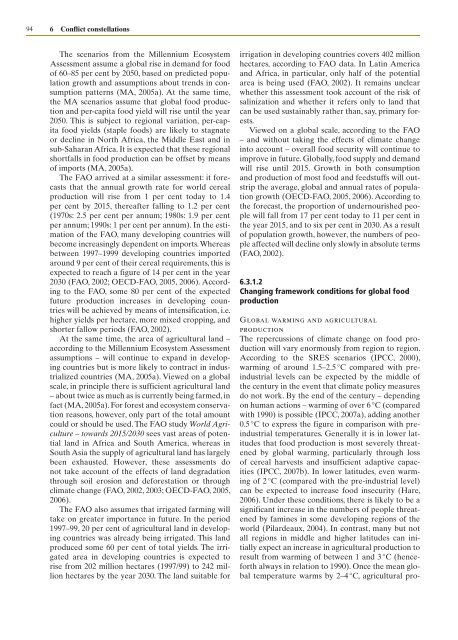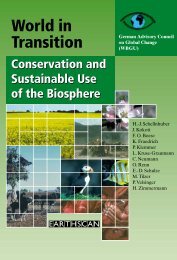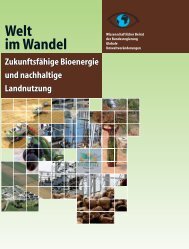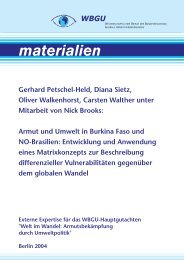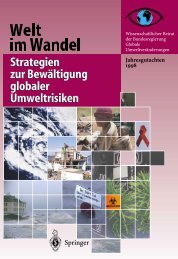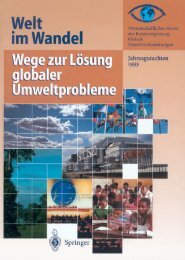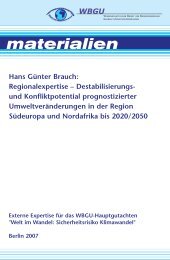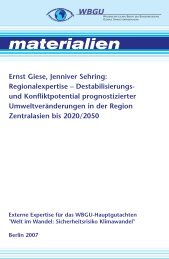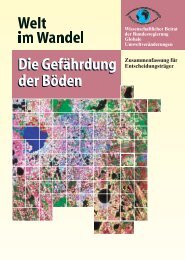World in Transition: Climate Change as a Security Risk - WBGU
World in Transition: Climate Change as a Security Risk - WBGU
World in Transition: Climate Change as a Security Risk - WBGU
You also want an ePaper? Increase the reach of your titles
YUMPU automatically turns print PDFs into web optimized ePapers that Google loves.
94<br />
6 Conflict constellations<br />
The scenarios from the Millennium Ecosystem<br />
Assessment <strong>as</strong>sume a global rise <strong>in</strong> demand for food<br />
of 60–85 per cent by 2050, b<strong>as</strong>ed on predicted population<br />
growth and <strong>as</strong>sumptions about trends <strong>in</strong> consumption<br />
patterns (MA, 2005a). At the same time,<br />
the MA scenarios <strong>as</strong>sume that global food production<br />
and per-capita food yield will rise until the year<br />
2050. This is subject to regional variation, per-capita<br />
food yields (staple foods) are likely to stagnate<br />
or decl<strong>in</strong>e <strong>in</strong> North Africa, the Middle E<strong>as</strong>t and <strong>in</strong><br />
sub-Saharan Africa. It is expected that these regional<br />
shortfalls <strong>in</strong> food production can be offset by means<br />
of imports (MA, 2005a).<br />
The FAO arrived at a similar <strong>as</strong>sessment: it forec<strong>as</strong>ts<br />
that the annual growth rate for world cereal<br />
production will rise from 1 per cent today to 1.4<br />
per cent by 2015, thereafter fall<strong>in</strong>g to 1.2 per cent<br />
(1970s: 2.5 per cent per annum; 1980s: 1.9 per cent<br />
per annum; 1990s: 1 per cent per annum). In the estimation<br />
of the FAO, many develop<strong>in</strong>g countries will<br />
become <strong>in</strong>cre<strong>as</strong><strong>in</strong>gly dependent on imports. Where<strong>as</strong><br />
between 1997–1999 develop<strong>in</strong>g countries imported<br />
around 9 per cent of their cereal requirements, this is<br />
expected to reach a figure of 14 per cent <strong>in</strong> the year<br />
2030 (FAO, 2002; OECD-FAO, 2005, 2006). Accord<strong>in</strong>g<br />
to the FAO, some 80 per cent of the expected<br />
future production <strong>in</strong>cre<strong>as</strong>es <strong>in</strong> develop<strong>in</strong>g countries<br />
will be achieved by means of <strong>in</strong>tensification, i.e.<br />
higher yields per hectare, more mixed cropp<strong>in</strong>g, and<br />
shorter fallow periods (FAO, 2002).<br />
At the same time, the area of agricultural land –<br />
accord<strong>in</strong>g to the Millennium Ecosystem Assessment<br />
<strong>as</strong>sumptions – will cont<strong>in</strong>ue to expand <strong>in</strong> develop<strong>in</strong>g<br />
countries but is more likely to contract <strong>in</strong> <strong>in</strong>dustrialized<br />
countries (MA, 2005a). Viewed on a global<br />
scale, <strong>in</strong> pr<strong>in</strong>ciple there is sufficient agricultural land<br />
– about twice <strong>as</strong> much <strong>as</strong> is currently be<strong>in</strong>g farmed, <strong>in</strong><br />
fact (MA, 2005a). For forest and ecosystem conservation<br />
re<strong>as</strong>ons, however, only part of the total amount<br />
could or should be used. The FAO study <strong>World</strong> Agriculture<br />
– towards 2015/2030 sees v<strong>as</strong>t are<strong>as</strong> of potential<br />
land <strong>in</strong> Africa and South America, where<strong>as</strong> <strong>in</strong><br />
South Asia the supply of agricultural land h<strong>as</strong> largely<br />
been exhausted. However, these <strong>as</strong>sessments do<br />
not take account of the effects of land degradation<br />
through soil erosion and deforestation or through<br />
climate change (FAO, 2002, 2003; OECD-FAO, 2005,<br />
2006).<br />
The FAO also <strong>as</strong>sumes that irrigated farm<strong>in</strong>g will<br />
take on greater importance <strong>in</strong> future. In the period<br />
1997–99, 20 per cent of agricultural land <strong>in</strong> develop<strong>in</strong>g<br />
countries w<strong>as</strong> already be<strong>in</strong>g irrigated. This land<br />
produced some 60 per cent of total yields. The irrigated<br />
area <strong>in</strong> develop<strong>in</strong>g countries is expected to<br />
rise from 202 million hectares (1997/99) to 242 million<br />
hectares by the year 2030. The land suitable for<br />
irrigation <strong>in</strong> develop<strong>in</strong>g countries covers 402 million<br />
hectares, accord<strong>in</strong>g to FAO data. In Lat<strong>in</strong> America<br />
and Africa, <strong>in</strong> particular, only half of the potential<br />
area is be<strong>in</strong>g used (FAO, 2002). It rema<strong>in</strong>s unclear<br />
whether this <strong>as</strong>sessment took account of the risk of<br />
sal<strong>in</strong>ization and whether it refers only to land that<br />
can be used susta<strong>in</strong>ably rather than, say, primary forests.<br />
Viewed on a global scale, accord<strong>in</strong>g to the FAO<br />
– and without tak<strong>in</strong>g the effects of climate change<br />
<strong>in</strong>to account – overall food security will cont<strong>in</strong>ue to<br />
improve <strong>in</strong> future. Globally, food supply and demand<br />
will rise until 2015. Growth <strong>in</strong> both consumption<br />
and production of most food and feedstuffs will outstrip<br />
the average, global and annual rates of population<br />
growth (OECD-FAO, 2005, 2006). Accord<strong>in</strong>g to<br />
the forec<strong>as</strong>t, the proportion of undernourished people<br />
will fall from 17 per cent today to 11 per cent <strong>in</strong><br />
the year 2015, and to six per cent <strong>in</strong> 2030. As a result<br />
of population growth, however, the numbers of people<br />
affected will decl<strong>in</strong>e only slowly <strong>in</strong> absolute terms<br />
(FAO, 2002).<br />
6.3.1.2<br />
Chang<strong>in</strong>g framework conditions for global food<br />
production<br />
Global warm<strong>in</strong>g and agricultural<br />
production<br />
The repercussions of climate change on food production<br />
will vary enormously from region to region.<br />
Accord<strong>in</strong>g to the SRES scenarios (IPCC, 2000),<br />
warm<strong>in</strong>g of around 1.5–2.5 °C compared with pre<strong>in</strong>dustrial<br />
levels can be expected by the middle of<br />
the century <strong>in</strong> the event that climate policy me<strong>as</strong>ures<br />
do not work. By the end of the century – depend<strong>in</strong>g<br />
on human actions – warm<strong>in</strong>g of over 6 °C (compared<br />
with 1990) is possible (IPCC, 2007a), add<strong>in</strong>g another<br />
0.5 °C to express the figure <strong>in</strong> comparison with pre<strong>in</strong>dustrial<br />
temperatures. Generally it is <strong>in</strong> lower latitudes<br />
that food production is most severely threatened<br />
by global warm<strong>in</strong>g, particularly through loss<br />
of cereal harvests and <strong>in</strong>sufficient adaptive capacities<br />
(IPCC, 2007b). In lower latitudes, even warm<strong>in</strong>g<br />
of 2 °C (compared with the pre-<strong>in</strong>dustrial level)<br />
can be expected to <strong>in</strong>cre<strong>as</strong>e food <strong>in</strong>security (Hare,<br />
2006). Under these conditions, there is likely to be a<br />
significant <strong>in</strong>cre<strong>as</strong>e <strong>in</strong> the numbers of people threatened<br />
by fam<strong>in</strong>es <strong>in</strong> some develop<strong>in</strong>g regions of the<br />
world (Pilardeaux, 2004). In contr<strong>as</strong>t, many but not<br />
all regions <strong>in</strong> middle and higher latitudes can <strong>in</strong>itially<br />
expect an <strong>in</strong>cre<strong>as</strong>e <strong>in</strong> agricultural production to<br />
result from warm<strong>in</strong>g of between 1 and 3 °C (henceforth<br />
always <strong>in</strong> relation to 1990). Once the mean global<br />
temperature warms by 2–4 °C, agricultural pro-


